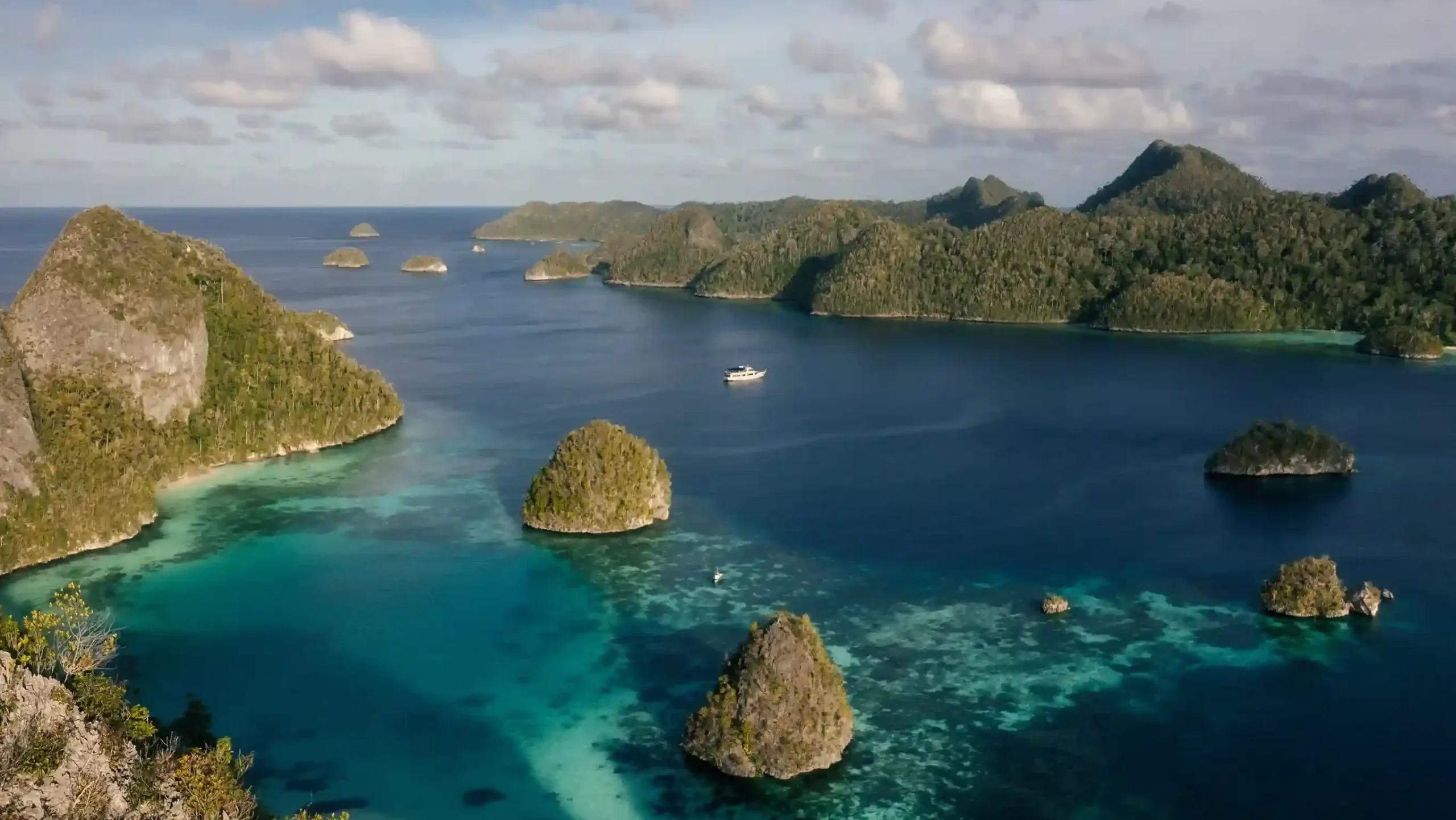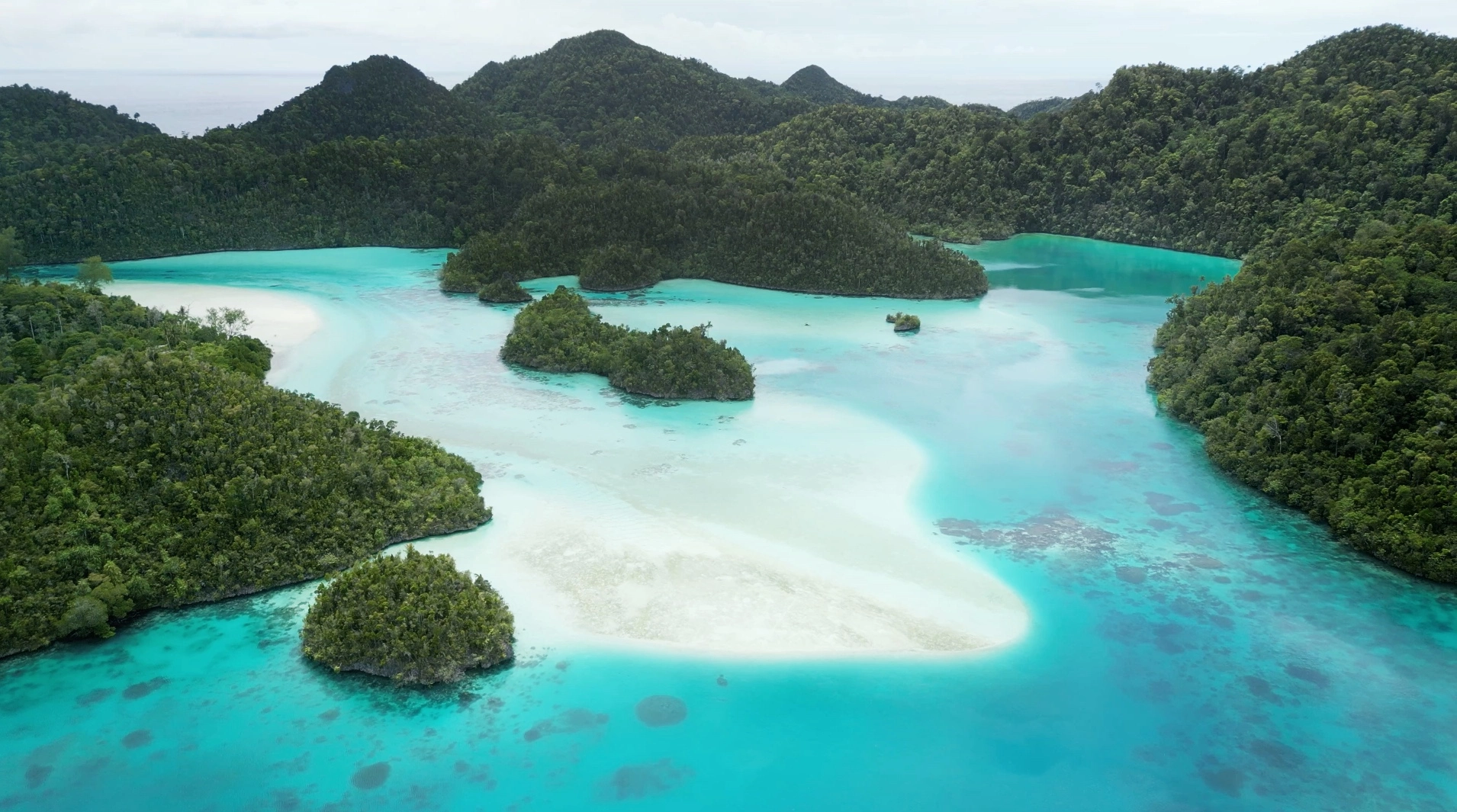
Raja Ampat, meaning "Four Kings" in Indonesian, is an archipelago of over 1,500 small islands, cays, and shoals located off the northwest tip of West Papua, Indonesia. This breathtaking region is globally renowned as a biodiversity hotspot, boasting the highest marine biodiversity on Earth. Imagine crystal-clear turquoise waters teeming with vibrant coral reefs, majestic manta rays gracefully gliding through the currents, and lush, jungle-covered islands rising dramatically from the sea. This is Raja Ampat, a destination that will forever change your perception of paradise.
This comprehensive guide will provide you with everything you need to know to plan your dream trip to Raja Ampat, from its fascinating history and stunning attractions to essential travel tips, the best time to visit, comfortable accommodations, delicious local food, and practical transportation options.
A Glimpse into Raja Ampat’s History and Culture:
Related Articles about Diving into Paradise: A Comprehensive Guide to Visiting the Raja Ampat Islands:
- A Grand Tour of the United Kingdom: History, Haunts, and Hopping Delights
- Portugal: A Tapestry of Sun, Sea, and Centuries of Charm
- Ha Long Bay: A Journey Through Emerald Waters and Limestone Wonders
- Casablanca’s Crown Jewels: A Guide to the Top Hotels and Unveiling the City’s Charms
- Unveiling the Bohemian Jewel: A Comprehensive Guide to the Top Things to Do in the Czech Republic
The history of Raja Ampat is intertwined with both local Papuan traditions and external influences. For centuries, the islands were inhabited by indigenous Papuan communities, each with their own unique customs, languages, and traditions. The "Four Kings" refer to the four main islands – Waigeo, Misool, Salawati, and Batanta – each historically ruled by a different Raja (king).
Historically, these kingdoms were tributaries of the Sultanate of Tidore, a powerful trading center in the Moluccas (Spice Islands). The Sultanate exerted its influence over the region, primarily through trade and the collection of tribute. However, local customs and governance remained largely intact.
European explorers, particularly the Portuguese and Dutch, passed through the region in the 16th and 17th centuries, but their impact was limited. It wasn’t until the 20th century, with the rise of diving tourism and conservation efforts, that Raja Ampat began to attract significant international attention.
Today, Raja Ampat is a unique blend of traditional Papuan culture and modern tourism. The local communities are deeply connected to the sea, and fishing remains a vital part of their livelihood. While tourism brings economic opportunities, it’s crucial to be mindful of the cultural sensitivities and support sustainable practices that protect the environment and respect the local way of life.
Unveiling Raja Ampat’s Main Attractions:
Raja Ampat offers a plethora of attractions, catering to a wide range of interests, from diving and snorkeling to island hopping and cultural immersion.
-
Underwater Paradise: The undisputed star of Raja Ampat is its underwater world. The region is home to over 75% of the world’s coral species, along with over 1,500 species of fish, including manta rays, reef sharks, pygmy seahorses, and countless other marine creatures.
- Diving: Raja Ampat is a diver’s dream. Iconic dive sites include:
- Cape Kri: Known for its incredible fish biomass, Cape Kri boasts an astonishing diversity of marine life.
- Blue Magic: A manta ray cleaning station where you can witness these majestic creatures up close.
- The Passage: A narrow channel between Waigeo and Gam Island, offering a unique diving experience with strong currents and abundant marine life.
- Melissa’s Garden: A vibrant coral garden teeming with colorful fish and invertebrates.
- Snorkeling: Even if you’re not a diver, you can still experience the magic of Raja Ampat through snorkeling. Many shallow reefs are easily accessible from the shore or by boat, offering incredible views of the coral and marine life.
- Diving: Raja Ampat is a diver’s dream. Iconic dive sites include:
-
Pianemo Viewpoint: Located on Fam Island, Pianemo offers arguably the most iconic view in Raja Ampat. Climb to the top of the viewpoint and be rewarded with a panoramic vista of emerald green islands scattered across the turquoise sea. It’s a perfect spot for taking breathtaking photos.
-
Wayag Islands: This stunning archipelago is characterized by its dramatic limestone karsts rising sharply from the sea. Wayag is a bit further afield and requires a longer boat trip, but the scenery is truly unforgettable. Climbing to the top of the viewpoint requires some effort but the reward is a vista that’s worth every drop of sweat.
-
Arborek Village: Experience the local Papuan culture by visiting Arborek Village on Mansuar Island. This charming village is known for its friendly locals, traditional houses, and vibrant handicrafts. You can learn about their way of life, purchase souvenirs, and even participate in cultural activities.
-
Pasir Timbul (Sandbar): At low tide, a beautiful sandbar emerges from the ocean, creating a pristine beach in the middle of the sea. It’s a perfect spot for swimming, sunbathing, and taking memorable photos.
-
Batanta Waterfall: Take a break from the marine wonders and explore the lush rainforest of Batanta Island. Hike to the Batanta Waterfall, a refreshing cascade surrounded by dense vegetation.
Essential Travel Tips for Raja Ampat:
Planning a trip to Raja Ampat requires careful consideration, as it’s a relatively remote and underdeveloped destination.
-
Best Time to Visit: The best time to visit Raja Ampat is during the dry season, which runs from October to April. During this period, the weather is generally calmer, the visibility is better for diving and snorkeling, and the seas are calmer for boat travel. The shoulder months of September and May can also be good options, offering a balance of good weather and fewer crowds. Avoid visiting during the monsoon season (June to August), as heavy rainfall and strong winds can disrupt travel plans.
-
Getting There: The main gateway to Raja Ampat is Sorong Airport (SOQ) in West Papua. From there, you’ll need to take a ferry or speedboat to Waisai, the capital of Raja Ampat located on Waigeo Island. From Waisai, you can then arrange boat transfers to your chosen accommodation or dive resort.
-
Permit: A Marine Park Entry Permit is required for all visitors to Raja Ampat. You can purchase this permit at the tourism office in Sorong or Waisai. The permit fee contributes to the conservation efforts in the region.
-
Currency: The Indonesian Rupiah (IDR) is the official currency. It’s advisable to bring enough cash, as ATMs are limited and credit card acceptance is not widespread, especially on smaller islands.
-
Language: The official language is Indonesian (Bahasa Indonesia). While English is spoken in some tourist areas, learning a few basic Indonesian phrases will be greatly appreciated by the locals.
-
Accommodation: Accommodation options in Raja Ampat range from basic homestays to luxurious resorts. Consider your budget and travel style when choosing your accommodation. Book in advance, especially during peak season.
-
Health and Safety: Consult your doctor about necessary vaccinations and malaria prophylaxis before traveling to Raja Ampat. Pack insect repellent, sunscreen, and a first-aid kit. Be aware of the strong currents and always swim or dive with a buddy.
-
Respect Local Culture: Dress modestly when visiting villages and religious sites. Ask for permission before taking photos of people. Be mindful of the local customs and traditions.
-
Sustainable Tourism: Support eco-friendly tourism practices by choosing accommodations and tour operators that prioritize environmental conservation and community involvement. Avoid using single-use plastics and dispose of your trash responsibly.
Where to Stay: Nearby Hotels and Accommodations:
Raja Ampat offers a diverse range of accommodation options to suit different budgets and preferences.
-
Luxury Resorts: For those seeking ultimate comfort and luxury, several high-end resorts offer stunning overwater bungalows, world-class diving facilities, and gourmet dining experiences. Examples include Misool Eco Resort and Papua Paradise Eco Resort.
-
Mid-Range Resorts: Many mid-range resorts offer comfortable bungalows with essential amenities, often located on beautiful beaches or overlooking the ocean. These resorts often include dive packages and boat transfers.
-
Homestays: For a more authentic and budget-friendly experience, consider staying in a homestay. Homestays are often run by local families and offer a chance to immerse yourself in the Papuan culture. While basic, they provide a unique and rewarding travel experience.
Savoring the Flavors: Local Food in Raja Ampat:
Raja Ampat’s cuisine is heavily influenced by its coastal location, featuring fresh seafood and local ingredients.
-
Ikan Bakar (Grilled Fish): A must-try dish in Raja Ampat. Freshly caught fish is grilled over charcoal and served with a variety of sauces, such as sambal (chili sauce) and kecap manis (sweet soy sauce).
-
Papeda: A staple food in Papua, Papeda is a sticky, glutinous porridge made from sago starch. It’s often served with fish soup or other savory dishes.
-
Sago Worms (Ulat Sagu): A traditional delicacy in Papua, sago worms are larvae that live in sago palm trees. They can be eaten raw, grilled, or fried. While not for everyone, trying sago worms is a unique cultural experience.
-
Fresh Seafood: Enjoy a variety of fresh seafood, including lobster, prawns, squid, and clams. Many restaurants and homestays offer freshly caught seafood cooked to your liking.
Navigating the Islands: Transportation Options:
Getting around Raja Ampat requires careful planning, as transportation options are limited and can be time-consuming.
-
Speedboats: Speedboats are the most common way to travel between islands. You can hire speedboats privately or join organized tours.
-
Local Boats: Local boats are a more affordable option, but they are slower and less comfortable than speedboats.
-
Ferries: Ferries connect Sorong to Waisai and other major islands. They are a budget-friendly option, but they can be crowded and slow.
Conclusion:
Visiting Raja Ampat is an unforgettable experience that will leave you in awe of its natural beauty and cultural richness. By planning your trip carefully, respecting the local culture, and supporting sustainable tourism practices, you can contribute to the preservation of this unique paradise for generations to come. So, pack your bags, grab your snorkel or dive gear, and prepare to dive into the breathtaking wonders of Raja Ampat!








